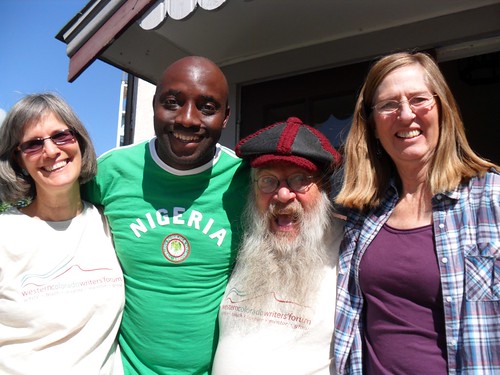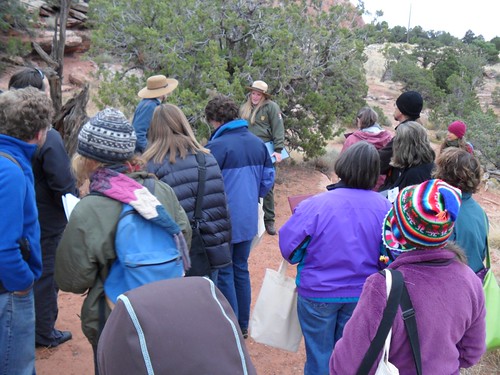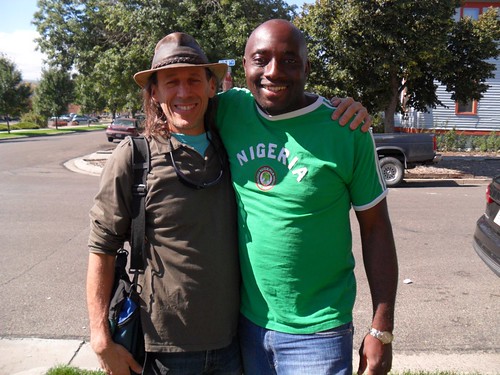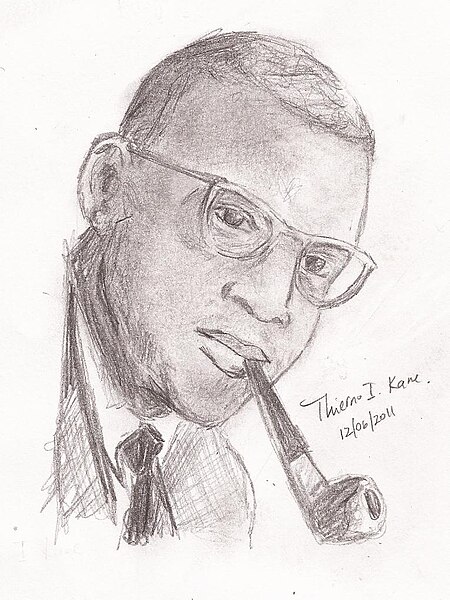I wandered lonely as a cloud and tried to figure outWhere all my customers had gone, to bring them back about;But from a million visitors how could I see the trend?What made them walk out of my store, and what did make them spend?And so I bought some software which could crunch the number stewAnd tell me as a business just exactly what to do.The best such tools let me explore without insisting on specifics;I asked a geek "so what's that called?" He said: "Smart Analytics."
I have a 2010 MacBook Pro which came with a 120GB SSD. I ran out of space on the drive and took it upon myself to upgrade to a bigger one. Found a great deal ($220) on this SanDisk Extreme 240GB 2.5" SATA III SSD and was ready to swap it out with the old drive. It turns out I'd lost out on the lottery and received one of the slower Toshiba SSDs rather than one of the faster Samsung ones, so I knew the SanDisk was bound to be an improvement. After making sure my Time Machine backup was up to date I cloned my old SSD to the new one using a SATA-to-USB dock and Carbon Copy Cloner.
I started by watching this video to get a sense of my way around the inside of the laptop. The video covers a slightly different task, but I wasn't looking for hand-holding, but just the general layout and gotchas. One of the things I gathered is that it's important to use high-quality philips and torx bits, and in my case I used a Wiha set. It was pretty easy to take out the old SSD and plug in the new one. I couldn't find my anti-static wristband, but I made sure to wear only cotton clothing, and to touch the power supply chasis of a nearby, plugged-in desktop PC every minute or so to avoid zapping anything.
With the new SSD in place, the first boot took an eternity. Almost ten seconds from pushing the power button to the grey Apple icon, and almost another ten seconds before the little spinny boot process indicator, but it did boot up fine. I've heard that SSDs need a few days to "settle in" before they're at proper performance levels, but other than the super-slow boot-up , I haven't had any other problems. I was back to working normally right away with the new SSD. Using Blackmagic Disk Speed Test I get speeds of around 220MB/s for read and 260MB/s for write, which is quite an improvement (and this is before any possible "settling.")
In the case where fear presses back
Through the air, where the torch has expired
On the orphan river,
In the forest, soulless and tired,
Under the anxious and faded trees,
In the wan woods, squalling trunks
Ululate without respite
Over the accursed tom-toms,
Black night! Black night!
Dans la case où la peur repasse
Dans l'air où la torche s'éteint,
Sur le fleuve orphelin
Dans la forêt sans âme et lasse
Sous les arbres inquiets et déteints,
Dans les bois obscurcis
Les trompes hurlent, hululent sans merci
Sur les tam-tams maudits,
Nuit noire ! Nuit noire !
- Major unrest in Burkina Faso last year
- Ethno-religious strife in Nigeria's middle belt
- Al-Quaeda-inspired terrorism in Nigeria's North
- The Nigerian fuel subsidy removal unrest
- An oil spill by Shell almost as bad as the Deepwater Horizon disaster (in terms of environmental impact rather than barrels of oil)
- South Sudan's independence
- Eradication of Rhinderpest
- Famine in East Africa
- The arrest of Gbagbo in Côte d'Ivoire following the mayhem he caused after elections
- The election of Ellen Johnson Sirleaf in Liberia
- One of the most engaging African Cup of Nations competitions in my own memory (OK I had to throw that last bit in there).
Écoute plus souvent
les choses que les êtres.
La voix du feu s'entend,
entends la voix de l'eau
écoute dans le vent
le buisson en sanglots.
I found the above video with the poem's recitation. I translate it thusly:
Listen more often
To things than to beings.
The fire's voice is heard,
Hear the voice of the water
Listen in the wind
To the bush a-sobbing.


Ubu’s work has, in part, been published. The attached paper is from her research. This will one day be regarded as a very important paper IMHO as it turns one of the theories of adhesion on its head. It shows weak adhesives give better strength in bonded structures than strong ones which is very counter-intuitive!
....Her work though on the reaction kinetics of silicone-based adhesives is still World-leading to this day. I really should find time to publish more! Out of interest her work has been presented at major conferences as far away as China so her theories of why things adhere and, importantly, why they fail have been quite widely circulated and discussed.

Out! Out! You must be prised right out
Joyless desire and love's conceit!
You've cranked at my heart such a treat,
Nothing's left there for your grubby onslaught.Now for my own good may I forget about,
Shrug off this tenant of my very suite.
Out! Out! You must be prised right out!I took you in without sufficient thought.
Get out! Go find yourself another beat!
Don't even skirt my heart's remotest street!
Too long I've dwelled cowed by your harsh, grim clout.
Out! Out! You must be prised right out!
Untitled - by Alain Chartier I turn you out of doors
tenant desire you pay no rent
I turn you out of doors
all my best rooms are yours
the brain and the heartdepart
I turn you out of doorsswitch off the lights
throw water on the fire
I turn you out of doorsstubborn desire

I turn you out of doors. Alain Chartier. BoLoP tr. by Edward Lucie-Smith
XI. Dehors ! dehors ! Il vous fault deslogier,
Désir sans joye et pensée d'amours. . .
Rondel de dix vers : Grenoble, n° 874, fol. 60 ; ms. du
cardinal de Rohan, fol. 80 v°; Lyon, n° 1235. Publié dans
Lyon- Revue, 1886, p. 315.
Rondeau/Chanczon XIDehors ! dehors ! Il vous fault deslogier
Desir sans joye et pensee d'amours!
Tant aves fait en mon cuer de voz tours
Qu'il n'y a plus pour vous que fourragier. Nonchaloir vueil desormais hebergier
Avec oubly pour moy donner secours.
Dehors ! dehors ! Il vous fault deslogier! Je vous receu ung pou trop de legier.
Departez vous! Allez logier aillours!
N'aprochez plus de mon cuer les faulxbours!
Trop ay vescu soubz vostre dur dangier.
Dehors ! dehors ! Il vous fault deslogier!
Doubting truth in unseen things
I seek the literal tree,
The prickly fruit, the leaves, the flowers
Some posit it to be.Uproot the tree of vegetable love
And plant a swooning spray—
I'm well across the gospel of
Our prelate Chartier.If love is nectar blossoming
But fades to autumn grief,
What heroes championing what gods
Are left to my belief?
I caught rumblings of the fuel subsidy removal affair while on my holiday travels, but only in the past few days have I gained a sense of just what a delicate moment in time this is for Nigeria.


Nigeria needs to keep to a formula based approach for determining fuel prices in the short term, while expediting actions in respect of putting in place a vibrant domestic refining industry.


by Chimezie Ogbuji
I recently had a need to manage a set of queries against an OWL2 EL biomedical ontology: the Foundational Model of Anatomy. I have an open source SPARQL service implementation that I had some thoughts about extending with support for managing queries. It’s called Triclops and is part of a collection of RDF libraries and tools I have been accumulating. The name is a reference to an initial attempt to build an RDF querying and navigation interface as part of the 4Suite repository back in the day (circa 2002).
This later evolved to a very rudimentary web interface that sat in front of the Oracle 11g and MySQL/SPARQL patient dataset that Cyc’s SKSI interacted with. This was part of an interface tailored to the task of identifying patient cohorts, known as the Semantic Research Assistant (SRA). A user could dispatch handwritten SPARQL queries, browse clickable results, or return them as CSV files. This capability was only used by informaticians familiar with the structure of the RDF dataset and most investigators used the SRA.
It also implemented a RESTful protocol for ticket-based querying that was used for stopping long-running SPARQL/MySQL queries. This is not currently documented. Around the time this was committed as an Apache-licensed, Google code library, layercake-python added core support for APIs that treated remote SPARQL services as local Graph objects as well as general support for connecting SPARQL services. This was based on Ivan Herman’s excellent SPARQL Endpoint interface to Python.
Triclops (as described in the wiki) can now be configured as a “Proxy SPARQL Endpoint”. It can be deployed as a light-weight query dispatch, management, and mediation kiosk for remote and local RDF datasets. The former capability (dispatching) was already in place, the latter (mediation) can be performed using FuXi’s recent capabilities in this regard.
Specifically, FuXi includes an rdflib Store that uses its sideways-information passing (sip) strategies the in-memory SPARQL algebra implementation for use as a general-purpose framework for semweb SPARQL (OWL2-RL/RIF/N3) entailment regimes. Queries are mediated over the SPARQL protocol using global schemas captured as various kinds of semweb ontology artifacts (expressed in a simple Horn form) that describe and distinguish their predicates by those instantiated in a database (or factbase) and those derived via the semantic properties of these artifacts.
So the primary capability that remained was query management and so this recent itch was scratched over the holidays. I discovered that CodeMirror , a JavaScript library that can be used to create a relatively powerful editor interface for code, had excellent support for SPARQL. I integrated it into Triclops as an interface for managing SPARQL queries and their results. I have a running version of this at http://metacognition.info/sparql/queryMgr. Note, the service is liable to break at any point as Webfaction kills of processes that use up alot of CPU and I have yet to figure out how to configure it to restart the service when it dies in such a fashion.
The dataset this interface manages queries for is a semantic web of content comprising 3 of the primary, ancient Chinese, classical texts (the Analects, Doctrine of the Mean, and the Tao Te Ching). I record the information in RDF because it is an intuitive knowledge representation to use in capturing provenance, exposition, and other editorial meta data. Below is a screen shot of the main page listing a handful of queries, their name, last date of modification, date of last run, and number of solutions in the recent result.

Above the list is a syntax-highlighted text area for dispatching adhoc SPARQL queries. This is where CodeMirror is integrated. If I click on the name of the query titled “Query for Analects and the Doctrine of the Mean english chapter text (Confucius)”, I go to a similar screen with another text area whose content corresponds to the text of the query (see the screen shot below).

From here queries can be updated (by submitting updated CodeMirror content) or cloned (using the name field for the new copy). Alternatively, the results of previous queries can be rendered. This sends back a result document with an XSLT processing instruction that causes the browser to trigger a request for a stylesheet and render an XHTML document from content in the result document on the client side.
Finally, a query can be re-executed against a dataset, saving the results and causing the information in the first screen to show different values for the last execution run (date and number of solutions). Results can also be saved or viewed as CSV using a different stylesheet against the result document.
The last capability added is a rudimentary template system where any variable in the query or text string of the form ‘$ …. $’ is replaced with a provided string or a URI. So, I can change the pick list value on the second row of the form controls to $searchExpression$ and type “water”. This produces a SPARQL query (visible with syntax highlighting via CodeMirror) that can be used as a template to dispatch queries against the dataset.
In addition, solutions for a particular variable can be used for links, providing a small framework for configurable, navigation workflows. If I enter “[Ww]ater” in the field next to $searchExpression$, select classic from the pick list at the top of the Result navigation template area, pick “Assertions in a (named) RDF graph” from the next pick list, and enter the graphIRI variable in the subsequent text input.
Triggering this form submission will produce the result screen pictured below. As specified in the form, clicking any of the the dbpedia links for the Doctrine of the Mean will initiate the invokation of the query titled “Assertions in a (named) RDF graph”, and shown below (with the graphIRI variable pre-populated with the corresponding URI):
SELECT DISTINCT ?s ?p ?o where {
GRAPH ?graphIRI {
?s ?p ?o
}
}
The result of such an action is shown in the screen shot. Alternatively, a different subsequent query can be used: “Statements about a resource”. The relationship between the schema of a dataset and the factbase can be navigated in a similar way. Picking the query titled “Classes in dataset” and making the following modifications. Select “Instances of a class and graph that the statements are asserted in” from the middle pick list of the Result navigation template section. Enter ?class in the text field to the right of this. Selecting ‘Execute..’ and executing this query results in a clickable result set comprised of classes of resources and clicking any such link shows the instances of that class.

This latter form of navigation seems well suited for exploring datasets for which either there is no schema information in the service or it is not well known by the investigator writing the queries.
In developing this interface, at least 2 architectural principles were re-used from my SemanticDB development days: the use of XSLT on the client side to build rich, offloaded (X)HTML applications and the use of the filesystem for managing XML documents rather than a relational database. The latter (use of a filesystem) is particularly more relevant where querying across the documents is not a major requirement or even a requirement at all. The former is via setting the processing instruction of a result document to refer to a dynamically generated XSLT document on the server.
The XSLT creates a tabular, row-distinguishing, tabular interface where the links to certain columns trigger queries via a web API that takes various input, including: the variable in the current query whose solutions are ‘streamed’, a (subsequent) query specified by some function of the MD5 hash of its title, a variable in that query that is pre-populated with the corresponding solution, etc:
../query=...&action=update&innerAction=execute,templateValue=...,&valueType=uri&variable=..
Eventually, the API should probably be made more RESTful and target the query, possibly leveraging some caching mechanism in the process. Perhaps it can even work in concert with the SPARQL 1.1 Graph Store HTTP Protocol.
by Chimezie Ogbuji
The response by the Health Care industry to the quality reporting requirements of the ACA and the subsequent response to that response (by the Dept. of Pres. Obama's HHS) of slashing the number of measures that need to be reported demonstrates how much the use of information systems (and informatics) in the medical information systems of the US is in the dark ages (as a director of clinical research once put it to me many times).
The informatics needs of converting relational healthcare data into various target variables for the purpose of aggregate "reporting" is a solved problem from the perspective of database theory, however risk averse healthcare providers shell out millions to hegemony-oriented software companies (whether it be those that sell shrink wrapped products or those that sell services) to solve trivial informatics problems.
I think there is a great opportunity for AI (in general), and logic-based knowledge representation (specifically) to be resurrected from the graveyard (or winter) of pure research into playing a prominent role in the engineering underlying what really needs to be done to lower the cost associated with leveraging information to make the provision of care more efficient.
Perhaps, even the idea of the Semantic Web (separate from the WWW-related technologies that enable it) can avoid falling for the same fate and be a part of this. However, the stewards of the places where peer-reviewed scientific research is done and literature is produced on the topic(s) of informatics (web-based informatics even) need to jettison the cancer of obsession with aesthetic / academic purity: novelty of methods described in written material, citation history of authors, thoroughness of literature review, etc. This cancer is what seems to separate pure (computer) science research from informatics, or the promulgation or accreditation of professional engineering (software or otherwise).
The development of standards, curricula, system methodology, and (ultimately) scientific literature needs to be more problem-focused (ergo engineering). The things that will make a difference will not be the things that are truly novel but those that involve the combination of engineering solutions that are novel and others that are mundane.
This world glistens like a summer lamp saying open, open
In the time it takes to speak, everything could disappear.
What is that spark when you meet a friend, which crackles with instant recognition? And what is that spark multiplied like a moonless night sky's field of fireworks? It might be something like what I experienced at the Western Colorado Writers' Forum's annual conference in Grand Junction this past weekend.

What better place to call home
than this high desert cloud mesa wrong turn
rippling of the continental plates
before they slap down
fanning towards the Coast?

We have no prairies
To slice a big sun at evening
Everywhere the eye concedes to
Encroaching horizon, Is wooed into the cyclops' eye
Of a tarn. Our unfenced country
Is bog that keeps crusting
Between the sights of the sun. They've taken the skeleton
Of the Great Irish Elk
out of the peat, set it up
An astounding crate full of air.

We have no tarn toMottle the copperplate faceOf rough entrada.We've no black peat, dry fossilColorado, we repeat.

It wasn’t the moon
that swooned me, but
the edge of the moon,
cratered and rough,
the shadow line
where substance ends
and space begins.
Maybe that is why we go on talking,
always trying to show someone we're here,
and look--I have a past just like you do,
a stream of words that fills the empty night
and sweetens troubled dreams, or so we hope,
and tells us not to linger long on bridges
staring at all the water passing by.I thought my whole ambition was to make
the past and present come together, dreamed
into a vivid shape that memory
could hold the way the land possesses rivers.
They in turn possess the land and carry it
in one clear stream of thought to drink from
or water gardens with.I learned that I must first talk to myself,
retelling stories, muttering a few
remembered lines of verse, to make the earth
substantial and to bring the sunlight back.
Only bone, like the shadow, knows
that lasting metaphors are born
of architects and alchemists,of those who love the arch
and beam, and of the fleshy need
to leave and have something remain.
It has been a crazy past few months. Not only has the day job been running at a gallop, but it's been full-on on the family front and back-to-school and all that. No shortage of activity in my corner of the poetry department, either. I've been posting a lot of interesting work at TNB Poetry, and other have been publishing a gratifying run of my own poems.
Maenads are snarling their decree:
‘So who d'you think you are,’ they howl
‘To seal your bonnet from the bee?’
Those bouncers at the Muses’ hill
Take down attendance in their hall—
You’re conscript to the gathering
To rouse the skaldic clan again
With clinking roar of brannigan.
Yield bruckle skin to miching flea.
Some randomized permutation of genes
Spelled these very left and right brain cortices–
Spotlight nerves on sheer possibility;
Some Mendel melody conjured these eyes,
These muscles, grafted these veins under this skin;
I am too many pin-point faults to be
By design yet I crown my own life's fitness:
I am perfected fortune of my chi.

I've stroked it while it gently weeps,
Caressed each trembling string,
Cranked up to weapons grade at times
I undertake to sing.And yet I disappoint, I rip,
I charm a wicked scar;
Hot venom as the scorpion bows
To cantor de Ronsard.If poetry and song provide
The island with a reef,
What heroes championing what gods
Are left to my belief?

Light on temples, Nepal to Sri Lanka,
You glide, traveling soul, earth-bound fixed foot,
Each step mounting from base camp Casablanca,From past-life luxury of Hatshepsut
To present serene, composed asana;




